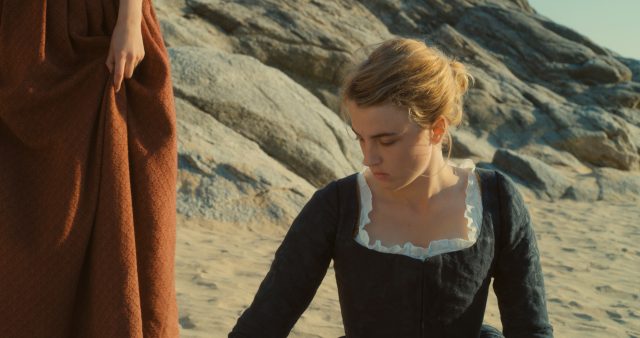TIFF 2019: Portrait of a Lady on Fire, by David Bax

Portraiture is one of the oldest, and therefore most conventional, artistic pursuits. And much of Céline Sciamma’s Portrait of a Lady on Fire is concerned with the creation of that traditionalist style of painting. Yet, when we see the work of art that bears the same title as the film, it is of a decidedly unconventional nature. Respected and established artistic conventions are embraced and insisted upon by those scared of change and the threat it exhibits to their cultural power. Sciamma sets us up to expect just that kind of movie, with its prestigious, Regency era sets and costumes, but gradually pivots into something unexpected that also happens to be one of the most powerful cinematic experiences of the year.
Noémie Merlant is Marianne, a professional painter who has been hired to come to an island in Brittany to paint a portrait of Héloïse (Adèle Haenel) a young lady who will be married off to a gentleman of Milan whom she’s never met, provided he approves of Marianne’s painting. But, since Héloïse refuses to be painted (as she refuses to be married), Marianne must pose as a maid, study Héloïse and paint her in secret. In flawless performances, Merlant (bold and self-assured) and Haenel (as intoxicating in sadness as in joy) inch Marianne and Héloïse into an all-consuming romance. Rounding out the phenomenal cast are Luàna Bajrami as Sophie, the household’s actual maid, and the always wonderful Valeria Golino as Héloïse’s mother, who commissioned Marianne in the first place.
So irresistible is the pull between Marianne and Héloïse that it’s hard to know whether to describe Portrait of a Lady on Fire as an erotically-charged romance or romantically-charged erotica. And yet the sex is never depicted in an abundantly graphic fashion. Sciamma (who also wrote the screenplay) and her two leads know that heat can be generated simply by two people knowing each other deeply. One of the film’s sexiest scenes concerns Marianne and Héloïse describing one another’s facial expressions.
There’s also the film’s entrancing tactility. Of course, that’s to be expected from the best period pieces, as the verisimilitude of woolen garments and wooden furniture sell the temporal illusion. Meanwhile, the light of Claire Mathon’s cinematography recalls that of Marianne’s brushstrokes. But Sciamma goes further, making sure we know what a piece of canvas fished out of the ocean feels like or how whispered French caresses the eardrum. By the time the two women finally kiss, we know what they’re feeling physically as well as emotionally.
Of course, Marianne and Héloïse’s time together is fleeting; the only reason they even met is so the latter can be married off to someone else. That’s why Sciamma is so preoccupied with the notion that, if you look away, something terrible might happen. Your suitcase might be blown overboard or the hem of your dress may come too close to a bonfire. But, once again veering toward the unexpected, Portrait of a Lady on Fire suggests that something wonderful just might happen too.





























